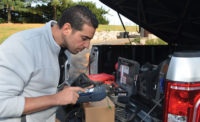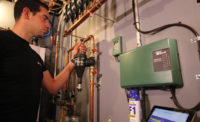Speed, reliability, and consistency are some key ingredients for the success of any business owner. My guys and I must do our best, all the time, to build these attributes into the work we do. But, of course, we also need to depend on our carefully chosen tools in much the same way. I’m rather manic about choosing the right hardware for my work.
Before I allow a tool into my work, I do a lot of online research. Then, I go for rigorous hands-on experience at trade shows, tool jamborees, or manufacturer demonstrations. I’ll also make it a point to speak with other trade users. Only then will I make a commitment.
After all, when I spend good money for tools, the price is almost the last thing on my mind. Much more important than the cost of a tool is its ability to keep pace with me and perform as expected under tight time constraints or when I’m far away from a replacement tool or attachment, like a blade or a bit.
My expectation of manufacturers, fair or not, is always to deliver on a promise. If they say a tool performs under tough conditions, joins metals, or tears through them with the greatest of ease, that instrument damn well better do it.
Another thought: The key purpose of trade tools is to make our lives as contractors easier, save our bodies, so we can last longer in the trade, and enable us to do things we’d otherwise be unable to do — meaning that someone else would be paid to do something we’re incapable of. So, bravo to tools, baby!
In my last column, I gave a pretty glowing review of the E-Instruments Combustion Analyzer and Milwaukee Tool’s cordless gear. They never let me down, so is it OK to confess my love for them? My wife accepts this, though not happily.
Next in my arsenal of reliable tools are Ridgid’s RP200 and the RP340.
Ridgid is numero uno in press tools for me. Their tools are the most diverse in the pressing world at allowing trade pros to press almost anything imaginable. They have a wide selection of heads for pressing all different materials.
You can press ½- to 2-inch copper and stainless steel using standard jaws. For larger copper and stainless steel tubing, users must invest in an additional kit that allows pressing of 2 ½- to 4-inch copper and stainless (XL-C).
For pressing pex, they have the Pureflow jaw set allowing users to press ½- to 2-inch pex. Mega press jaws are designed for schedules 5-40 pipe and pipe sizes ranging from ½ inch to 2 inches in size.
My favorite of all the heads is the cast-iron jaw set, which allows users to cut cast iron no hub with ease. From 1 ½-4 inch, it’s simple; it’s the efficiency of this tool that just pays for itself.
Work in tight or confined spaces, such as under cabinets or in framing, can be difficult. The orientation of a fitting can toss a challenge our way, too.
But, no worries: Ridgid has a set of press rings that allows users to press fittings in the tightest of places, and these rings connect to a ball tip actuator jaw that achieves an additional 100 degrees of rotation. The jaw set rotates 270 degrees and uses a bolt-sensing technology that ensures the jaw is seated securely before allowing a press.
These tools have saved me countless times on emergency calls and allowed me to work quickly to complete the task at hand. New Ridgid press tools also indicate when the batteries run low, when working temps are too high or too low, and when service is due.
Thanks, Ridgid, for knowing that my time is the most valuable commodity of all.
Another big time-saver for me is Taco’s free FloPro Designer software.
From experience, I know that Taco is always updating its popular FloPro Designer software, which is a residential hydronic system design tool that I use frequently to easily design systems.
With this software, which I access at home, in the shop, or on a job site via my surface pro, I can literally do it all — from heat load calculations to equipment selection and sizing to system and near boiler piping. The numbers don’t lie.
The tool automatically selects the right equipment and creates the documents needed to get the job done right, including layout schematics, near boiler piping layouts, bills of materials, load summaries, and detailed schedule reports.
FloPro Designer also has an intuitive, easy-to-use, drag-and-drop interface. Users begin by drawing walls to scale and then adding doors and windows. As I make decisions about a system design or make changes, the software tracks what I’m doing and calculates loads as features are added. It’s easy to connect a boiler or drop in pumps, tanks, zone valves, and more.
The software recalculates as I draw, automatically changing specifications and preparing bills of materials. It also offers accurate equipment selections based on actual equipment head loss calculations — even indirect water heater loads.
It’s also familiar with Boiler Wizard piping layouts and provides an AutoFill that automatically fills in the location for all components within specific rooms.
Anyone who wants to look into it can check out the freeware at www.tacocomfort.com. Ra Puriri is Taco’s specialist on this software. He knows the software like the back of his hand and is always there to help. There are videos and training tutorials available to help you get more comfortable with the software. Puriri has helped me countless times on the job, and I can’t thank him enough.
And thanks, Taco, for affirming the value of my time and expertise. You’ve made me a better trade professional in so many ways.
Publication date: 4/10/2017










